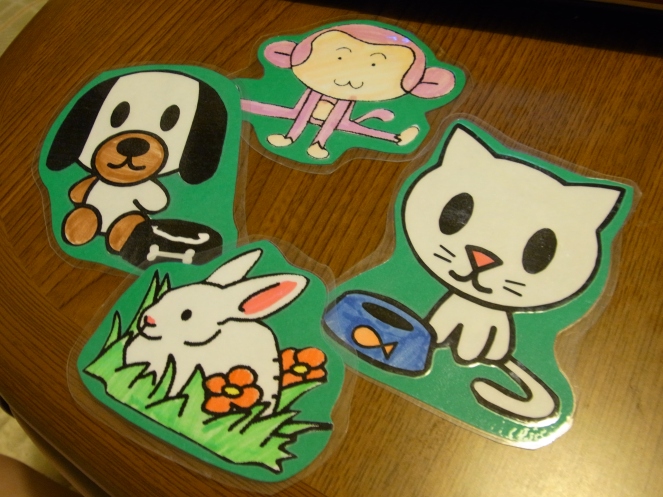
My 6th graders are just superstars. What is even more exciting is that I am starting to be able to read their names on their name tags (screw you kanji!), so I can call them by name. It is always nice to be able to say “Haruka” instead of just pointing and saying どうぞ.
 greet with students
greet with students

 Let’s Play pg. 13
Let’s Play pg. 13
In this activity, students were asked to connected upper case letters to their lower case counterparts. Before starting the activity, I ask my students if they thought they could complete the activity in under 10 minutes – to which they all agreed they could. They probably could have finished it sooner had they not all pulled out their rulers to draw perfectly straight lines between the letters. When students completed the activity, I gave them a chocolate scented stamp – something that the kids go crazy for.
 Activity pg 10 – 11
Activity pg 10 – 11

I mentioned that I did this activity in a previous post, but I was actually only able to finish it in one. For that class, I quizzed kids on all the foreign languages. To my great surprise, the kids not only remembered the languages (in English) they also remembered all the animals (both in English and in the languages represented).
 Review the expression “How many?”
Review the expression “How many?”
They learned this expression when they were 5th graders, so they all just needed a small reminder of the meaning.

I put a bunch of animal cards on the board and asked the how many of each animal there was. Students were easily able to answer in numbers, but I decided to challenge them a little more. I explained that since they were 6th graders, just giving a number answer was not enough. Instead, they should say “6 dogs.” Part of my thinking for this is that whenever I correct Jr. high school papers, students constantly forget to add the “s” almost every single time. Hopefully, at least for my current group of students, by having to say it aloud all the time, they will remember to write it when they are in Jr. high school.
 Review and say good-bye with students
Review and say good-bye with students
I just learned this week that my new boss will be coming to observe my elementary school classes. Last year, this was not very fun as the boss then got very upset that I was writing English on the board. Sorry to be writing English on the board in an English class. I have no idea what the new guy is looking for, but hopefully he will not reprimand me in front of my students like the other guy did.

That’s fab that your kanji skills are getting so much better! I’ve been (slowly) working my way through Heisig’s book, but kanji are definitely my weak point with Japanese. Especially after not having a Japanese class for a year. ><
And I'm still loving your lesson plan posts. They're so reassuring now that my JET departure is only six weeks away.
It’s not so much of me getting better at kanji (name kanji and “regular” kanji might as well be different languages), but that I have heard teachers say the names enough that I am starting to remember how to read some of the more complicated kanji name compounds. Teaching over 400 students in a week will give you a lot of kanji practice if you pay attention.
Please, PLEASE hook me up with one of those chocolate-scented stamps. I want one for my class and two for myself. 🙂
haha. Better get them while you are still in the States then! Should sell them at any teaching supply store.
This is a great lesson. I’d love to try it on some kids one day and see if they could figure it out.